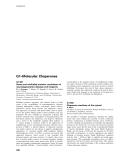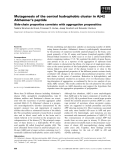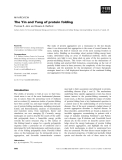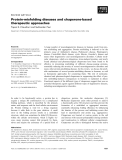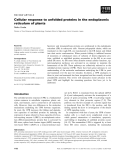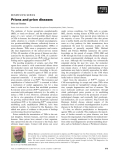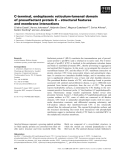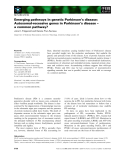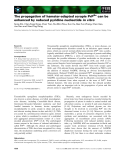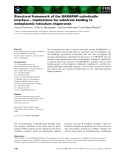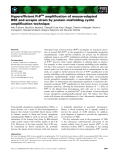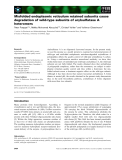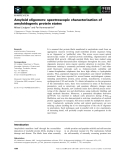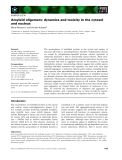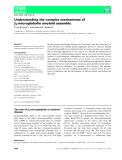
Protein misfolded
-
Microvesicles (đôi khi được gọi là exosomes) là những mảnh của màng tế bào khác nhau, sinh ra từ hầu như tất cả các loại tế bào. Microvesicles đóng một vai trò trong việc truyền thông tin nội bào và có thể vận chuyển mRNA và protein giữa các tế bào.
 16p
16p  kecodon360
kecodon360
 30-08-2013
30-08-2013
 117
117
 11
11
 Download
Download
-
Misfolded proteins, aggregates, and inclusion bodies are hall-marks of the cytopathology of neurodegenerative disorders including Huntington’s disease, Amyotropic lateral sclerosis, Parkinson’s disease, Prion diseases, and Alzheimer’s disease. The appearance of proteins with altered folded states is regula-ted by the protein folding quality control machinery and age-dependent. We have identified an unexpected molecular link between metabolic state, accumulation of damaged proteins, the heat-shock response and chaperones, and longevity....
 61p
61p  fptmusic
fptmusic
 11-04-2013
11-04-2013
 46
46
 5
5
 Download
Download
-
Protein misfolding and deposition underlie an increasing number of debili-tating human disorders. Alzheimer’s disease is pathologically characterized by the presence of numerous insoluble amyloid plaques in the brain, com-posed primarily of the 42 amino acid humanb-amyloid peptide (Ab42). Disease-linked mutations in Ab42 occur in or near a central hydrophobic cluster comprising residues 17–21.
 11p
11p  dell39
dell39
 27-03-2013
27-03-2013
 37
37
 5
5
 Download
Download
-
The study of protein aggregation saw a renaissance in the last decade, when it was discovered that aggregation is the cause of several human dis-eases, making this field of research one of the most exciting frontiers in science today. Building on knowledge about protein folding energy land-scapes, determined using an array of biophysical methods, theory and simulation, new light is now being shed on some of the key questions in protein-misfolding diseases.
 9p
9p  dell39
dell39
 27-03-2013
27-03-2013
 33
33
 3
3
 Download
Download
-
A large number of neurodegenerative diseases in humans result from pro-tein misfolding and aggregation. Protein misfolding is believed to be the primary cause of Alzheimer’s disease, Parkinson’s disease, Huntington’s disease, Creutzfeldt–Jakob disease, cystic fibrosis, Gaucher’s disease and many other degenerative and neurodegenerative disorders.
 19p
19p  inspiron33
inspiron33
 26-03-2013
26-03-2013
 69
69
 5
5
 Download
Download
-
Secretory and transmembrane proteins are synthesized in the endoplasmic reticulum (ER) in eukaryotic cells. Nascent polypeptide chains, which are translated on the rough ER, are translocated to the ER lumen and folded into their native conformation. When protein folding is inhibited because of mutations or unbalanced ratios of subunits of hetero-oligomeric pro-teins, unfolded or misfolded proteins accumulate in the ER in an event called ER stress.
 20p
20p  galaxyss3
galaxyss3
 21-03-2013
21-03-2013
 28
28
 5
5
 Download
Download
-
1The epidemic of bovine spongiform encephalopathy (BSE), or ‘mad cow disease’, and the subsequent emer-gence of a new variant of Creutzfeldt–Jakob disease (vCJD) in humans, has directed great political and sci-entific attention to a family of related neurodegenera-tive protein-misfolding diseases, collectively known as transmissible spongiform encephalopathies (TSEs) or prion diseases.
 1p
1p  galaxyss3
galaxyss3
 21-03-2013
21-03-2013
 51
51
 3
3
 Download
Download
-
After the successful cloning of the first gene for a polyglutamine disease in 1991, the expanded polyglutamine tract in the nine polyglutamine disease proteins became an obvious therapeutic target. Early hypotheses were that misfolded, precipitated protein could be a universal pathogenic mechanism. However, new data are accumulating on Huntington’s disease and other polyglutamine diseases that appear to contradict the toxic aggregate hypothesis.
 11p
11p  galaxyss3
galaxyss3
 07-03-2013
07-03-2013
 55
55
 5
5
 Download
Download
-
Surfactant protein C (SP-C) constitutes the transmembrane part of prosurf-actant protein C (proSP-C) and isa-helical in its native state. The C-termi-nal part of proSP-C (CTC) is localized in the endoplasmic reticulum lumen and binds to misfolded (b-strand) SP-C, thereby preventing its aggregation and amyloid fibril formation.
 12p
12p  media19
media19
 05-03-2013
05-03-2013
 28
28
 4
4
 Download
Download
-
Protein misfolding is recognized as an important pathophysiological cause of protein deficiency in many genetic disorders. Inherited mutations can disrupt native protein folding, thereby producing proteins with misfolded conformations.
 10p
10p  media19
media19
 04-03-2013
04-03-2013
 24
24
 2
2
 Download
Download
-
Rare, inherited mutations causing familial forms of Parkinson’s disease have provided insight into the molecular mechanisms that underlie the genetic and sporadic forms of this disease. Loss of protein function result-ing from autosomal-recessive mutations in PTEN-induced putative kinase 1 (PINK1), Parkin and DJ-1 has been linked to mitochondrial dysfunction, accumulation of abnormal and misfolded proteins, impaired protein clear-ance and oxidative stress.
 9p
9p  vinaphone15
vinaphone15
 28-02-2013
28-02-2013
 39
39
 3
3
 Download
Download
-
Transmissible spongiform encephalopathies (TSEs), or prion diseases, are fatal neurodegenerative disorders caused by an infectious agent termed a prion, which can convert normal cellular prion protein (PrP C ) into a patho-logically misfolded isoform (PrP Sc ). Taking advantage of protein misfolding cyclic amplification (PMCA), a series of experiments was conducted to investigate the possible influences of pyridine nucleotides on the propaga-
 10p
10p  vinaphone15
vinaphone15
 27-02-2013
27-02-2013
 40
40
 2
2
 Download
Download
-
Endoplasmic reticulum (ER)-associated degradation (ERAD) is a cell-autonomous process that eliminates large quantities of misfolded, newly synthesized protein, and is thus essential for the survival of any basic eukaryotic cell.
 13p
13p  vinaphone15
vinaphone15
 27-02-2013
27-02-2013
 24
24
 2
2
 Download
Download
-
Abnormal forms of prion protein (PrP Sc ) accumulate via structural conver-sion of normal PrP (PrP C ) in the progression of transmissible spongiform encephalopathy. Under cell-free conditions, the process can be efficiently replicated usingin vitro PrP Sc amplification methods, including protein mis-folding cyclic amplification.
 8p
8p  viettel02
viettel02
 22-02-2013
22-02-2013
 21
21
 2
2
 Download
Download
-
Arylsulfatase A is an oligomeric lysosomal enzyme. In the present study, we use this enzyme as a model protein to examine how heteromerization of wild-type and misfolded endoplasmic reticulum-degraded arylsulfatase A polypeptides affects the quality control of wild-type arylsulfatase A subun-its.
 11p
11p  viettel02
viettel02
 19-02-2013
19-02-2013
 36
36
 4
4
 Download
Download
-
It is assumed that protein fibrils manifested in amyloidosis result from an aggregation reaction involving small misfolded protein sequences being in an ‘oligomeric’ or ‘prefibrillar’ state. This review covers recent optical spectroscopic studies of amyloid protein misfolding, oligomerization and amyloid fibril growth.
 9p
9p  mobifone23
mobifone23
 18-01-2013
18-01-2013
 49
49
 3
3
 Download
Download
-
The accumulation of misfolded proteins in the cytosol and nucleus of neuronal cells leads to neurodegenerative disorders. Polyglutamine diseases are caused by polyglutamine-expanded proteins, whereas mutations in superoxide dismutase 1 lead to amyotrophic lateral sclerosis.
 11p
11p  mobifone23
mobifone23
 18-01-2013
18-01-2013
 41
41
 3
3
 Download
Download
-
Several protein misfolding diseases are associated with the conversion of native proteins into ordered protein aggregates known as amyloid. Studies of amyloid assemblies have indicated that non-native proteins are responsi-ble for initiating aggregationin vitro andin vivo.
 16p
16p  cosis54
cosis54
 04-01-2013
04-01-2013
 36
36
 3
3
 Download
Download
-
REVIEW ARTICLE Hanna Willander1,2, EriThe BRICHOS domain was initially defined from sequence alignments of the Bri protein associated with familial dementia, chondromodulin associ-ated with chondrosarcoma and surfactant protein C precursor (proSP-C) associated with respiratory distress syndrome and interstitial lung disease (ILD). Today BRICHOS has been found in 12 protein families.
 12p
12p  cosis54
cosis54
 09-12-2012
09-12-2012
 46
46
 3
3
 Download
Download
CHỦ ĐỀ BẠN MUỐN TÌM










